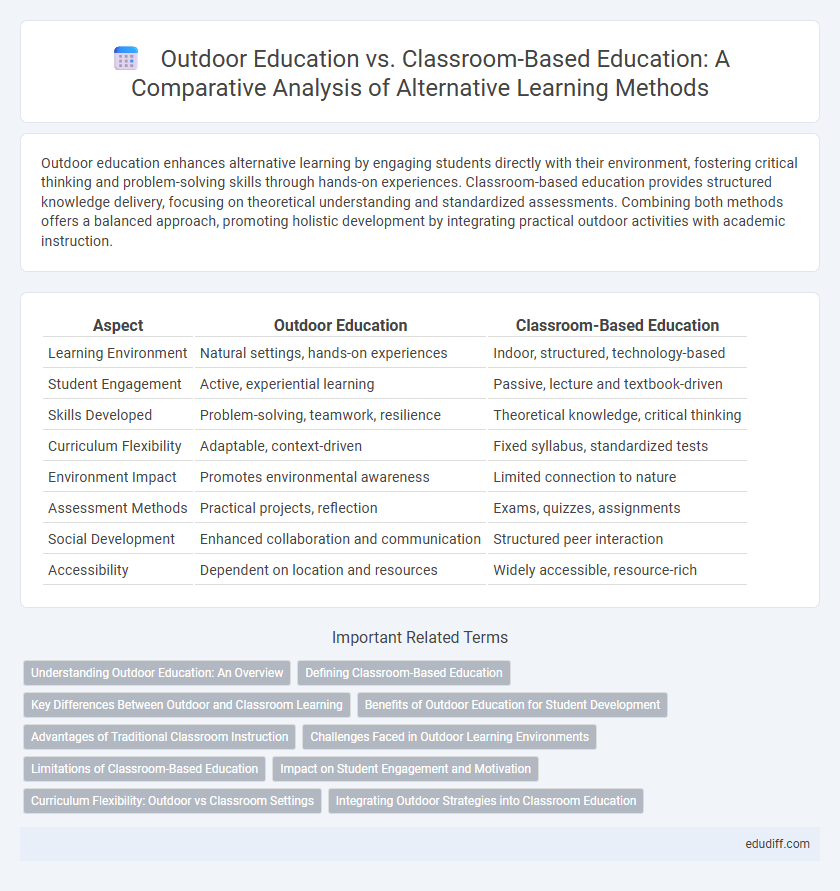Outdoor education enhances alternative learning by engaging students directly with their environment, fostering critical thinking and problem-solving skills through hands-on experiences. Classroom-based education provides structured knowledge delivery, focusing on theoretical understanding and standardized assessments. Combining both methods offers a balanced approach, promoting holistic development by integrating practical outdoor activities with academic instruction.
Table of Comparison
| Aspect | Outdoor Education | Classroom-Based Education |
|---|---|---|
| Learning Environment | Natural settings, hands-on experiences | Indoor, structured, technology-based |
| Student Engagement | Active, experiential learning | Passive, lecture and textbook-driven |
| Skills Developed | Problem-solving, teamwork, resilience | Theoretical knowledge, critical thinking |
| Curriculum Flexibility | Adaptable, context-driven | Fixed syllabus, standardized tests |
| Environment Impact | Promotes environmental awareness | Limited connection to nature |
| Assessment Methods | Practical projects, reflection | Exams, quizzes, assignments |
| Social Development | Enhanced collaboration and communication | Structured peer interaction |
| Accessibility | Dependent on location and resources | Widely accessible, resource-rich |
Understanding Outdoor Education: An Overview
Outdoor education emphasizes experiential learning through direct interaction with natural environments, improving physical skills, social interaction, and environmental awareness. It incorporates activities such as hiking, camping, and team-building exercises, fostering practical knowledge and problem-solving abilities. Studies demonstrate that outdoor education enhances student engagement, motivation, and retention compared to traditional classroom-based methods.
Defining Classroom-Based Education
Classroom-based education refers to structured learning environments where instruction is delivered by teachers within a physical or virtual classroom setting, emphasizing standardized curricula and assessments. It relies on direct interaction between students and educators, often prioritizing theoretical knowledge and cognitive skill development. This traditional educational model supports systematic evaluation and consistency in academic achievement across diverse subjects.
Key Differences Between Outdoor and Classroom Learning
Outdoor education emphasizes experiential learning through direct interaction with nature, promoting physical activity, environmental awareness, and practical problem-solving skills. Classroom-based education relies on structured curricula, standardized assessments, and theoretical knowledge delivery within controlled environments. Key differences include learning context, sensory engagement, and the development of social and cognitive skills tailored to real-world experiences versus academic frameworks.
Benefits of Outdoor Education for Student Development
Outdoor education enhances student development by promoting hands-on learning, critical thinking, and problem-solving skills in real-world environments. Exposure to nature improves mental health, reduces stress, and increases engagement and motivation compared to traditional classroom settings. Physical activities in outdoor education support motor skill development and foster teamwork and social interaction among students.
Advantages of Traditional Classroom Instruction
Traditional classroom instruction offers structured learning environments that facilitate direct interaction between teachers and students, enhancing immediate feedback and personalized support. It provides access to a wide range of educational resources such as textbooks, multimedia tools, and lab equipment, which are essential for comprehensive subject understanding. The consistency and routine of classroom settings help students develop discipline, social skills, and collaborative abilities critical for academic and personal growth.
Challenges Faced in Outdoor Learning Environments
Outdoor education presents challenges such as unpredictable weather conditions, safety risks, and limited access to resources, which can disrupt learning continuity. Instructors must adapt lesson plans dynamically to maintain student engagement and ensure educational objectives are met despite environmental constraints. Additionally, logistical issues including transportation and securing suitable outdoor locations can hinder consistent program implementation.
Limitations of Classroom-Based Education
Classroom-based education limits experiential learning opportunities that outdoor education provides, such as hands-on interaction with natural environments and real-world problem-solving. It often relies on passive learning methods, reducing student engagement and retention compared to active outdoor experiences. The confined indoor setting restricts physical activity and sensory stimulation, essential for holistic development and cognitive growth.
Impact on Student Engagement and Motivation
Outdoor education significantly enhances student engagement and motivation by offering experiential learning opportunities that stimulate curiosity and active participation. Studies show that students involved in outdoor learning demonstrate higher levels of enthusiasm and persistence compared to those in traditional classroom settings. Incorporating nature-based activities promotes intrinsic motivation and improves cognitive retention, leading to more meaningful educational outcomes.
Curriculum Flexibility: Outdoor vs Classroom Settings
Outdoor education offers dynamic curriculum flexibility by adapting lessons to natural environments and real-world experiences, enhancing student engagement and practical learning. Classroom-based education typically follows a fixed curriculum, limiting opportunities for experiential learning and adaptability to individual student needs. Emphasizing outdoor education promotes holistic development through interactive, context-driven activities that foster critical thinking and environmental awareness.
Integrating Outdoor Strategies into Classroom Education
Integrating outdoor strategies into classroom education enhances student engagement and retention by promoting experiential learning and real-world application of concepts. Outdoor activities such as nature-based projects, field trips, and environmental science labs cultivate critical thinking, collaboration, and sensory awareness in diverse learning environments. Research indicates that blending outdoor education with traditional classroom instruction improves academic performance and fosters holistic development.
Outdoor Education vs Classroom-Based Education Infographic

 edudiff.com
edudiff.com